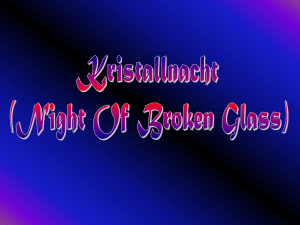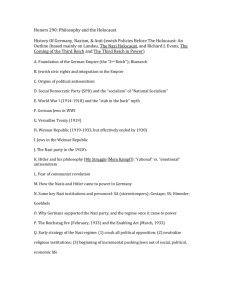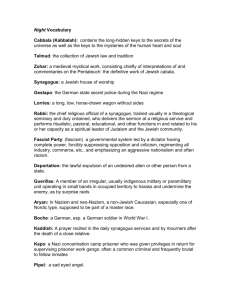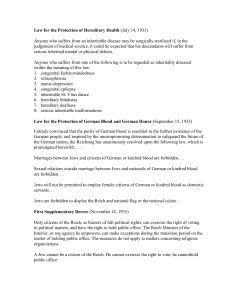The Nuremberg Laws and Kristallnacht
advertisement
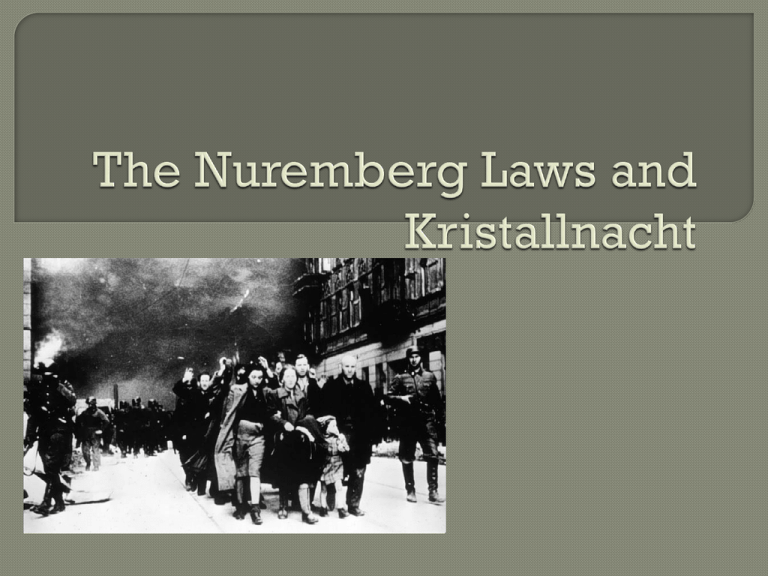
From the moment the Nazis came to power in 1933, the Jews of Germany were subjected to a never-ending series of discriminatory laws. There would be, during the twelve years of Hitler's Reich, over 400 separate regulations issued against Jews prohibiting everything from performing in a symphony orchestra to owning a pet cat. On April 1 1933, the Nazi regime called for a national boycott of all Jewish business. Lists of specific businesses and individuals to be boycotted were published. German Jewish leaders were ordered to deny reports of Nazi atrocities committed against Jews. The boycott lasted three days and revealed the efficiency of Nazi intelligence on Jewish economic life. The idea that it was permissible to destroy life without impunity was strengthened Stormtroopers outside a Berlin store posting signs with the words ‘Germans! Defend yourselves! Do not buy from Jews!’ At their annual party rally on 15 September 1935, the Nazis announced new laws called the Nuremberg Race Laws These laws deprived German Jews of their rights of German citizenship, giving them the status of "subjects" in Hitler's Reich. The laws also made it forbidden for Jews to marry or have sexual relations with Aryans or to employ young Aryan women as household help. (An Aryan being a person with blond hair and blue eyes of Germanic heritage.) The Nuremberg Laws defined a person as a “Jew” as someone three or four Jewish grandparents. They also classified thousands of people who had concerted to Judaism from another religion as Jewish. Crowds of people at the 1935 Nazi rally at Nuremberg The introduction of the Nuremberg Laws Entirely convinced that the purity of German blood is essential to the further existence of the Germanpeople, and inspired by the uncompromising determination to safeguard the future of the German nation, the Reichstag has unanimously adopted the following law, which is promulgated herewith: I. 1. Marriages between Jews and citizens of German or kindred blood are forbidden. Marriages concluded in defiance of this law are void, even if, for the purpose of evading this law, they were concluded abroad. 2. Proceedings for annulment may be initiated only by the Public Prosecutor. II. Sexual relations outside marriage between Jews and nationals of German of kindred blood are forbidden. III. Jews will not be permitted to employ female citizens of German or kindred blood under 45 years of age as domestic servants. IV. 1. Jews are forbidden to display the Reich and national flag or the national colors. 2. On the other hand they are permitted to display the Jewish colors. The exercise of this right is protected by the State.... As a result, two months later a supplemental Nazi decree was issued which defined a "full Jew" as a person with at least three Jewish grandparents. Those with fewer than three grandparents were designated as Mischlinge (half-breeds), of which there were two degrees: First Degree Mischlinge – a person with two Jewish grandparents; Second Degree ischlinge – a person with one Jewish grandparent. The Nazis also issued somewhat complicated instructional charts to help bureaucrats distinguish the various degrees of Jewishness. Generally, the more "full-blooded" a Jew was, the greater the level of discrimination. But much of the confusion remained. In many cases, the necessary genealogical evidence concerning Jewish family backgrounds was simply not available. Instructional chart issued to help bureaucrats distinguish Jews from Mischlinge (mixed race persons) and Aryans. The white figures are Aryans; the black figures Jews; and the shaded figures Mischlinge. I. 1. A subject of the State is a person who belongs to the protective union of the German Reich, and who therefore has particular obligations towards the Reich. 2. The status of subject is acquired in accordance with the provisions of the Reich and State Law of Citizenship. II. 1. A citizen of the Reich is that subject only who is of German or kindred blood and who, through his conduct, shows that he is both desirous and fit to serve the German people and Reich faithfully. •Loss of citizenship was the most important step in the process that lead to the ultimate exclusion and murder of German Jews. Citizenship, at that time, was the only status that conferred specific rights and privileges on individuals before International Law asserted that people have rights regardless of whether or not they have citizenship under a nation state. This law required all persons wanting to marry to submit to a medical examination, after which a "Certificate of Fitness to Marry" would be issued if they were free of diseases. The certificate was required for a marriage license From the time the Nuremberg Laws were passed until 1938, sporadic legislation resulted in further severity against Jews. Street names that sounded Jewish were changed and Jews whose first names did not sound "Jewish" had to add "Israel" or "Sarah" to their names. Passports and identity cards were marked with a "J" for Jude. To enforce these laws, the SS increasingly began to take power over the Jews. The result of the Nuremberg Laws and the regulations which followed was to bring together the various policies toward Jews, which had been inconsistent and contradictory Anti-Semitism existed before the Nuremberg Laws of 1935 However, the Nuremberg Laws institutionalised anti-Semitism and stripped German Jews of their citizenship and several of their political and economic rights The Nuremberg Laws were an important step toward the Nazi goal to exterminate all Jews. The Nazis now had a definition that was escalating in severity and leading to the destruction of European Jewry. Once Jews could be defined and identified, they could be segregated socially, politically, and economically from other Germans. Jews were now outside the protection of a state they had placed their confidence in for generations. Kristallnacht – Night of the Broken Glass A pogrom – or series of attacks - against Jewish people throughout Nazi Germany and parts of Austria on November 9-10, 1938 These attacks were triggered by the assassination of German diplomat Ernst vom Rath by Herschel Grynszpan by a Germanborn Polish Jew in Paris, France on 7 November 1938. Following this assassination, Nazi Propaganda Minister Joseph Goebbels delivered a speech in which he commented that "the Führer has decided that… demonstrations [against the assassination] should not be prepared or organised by the party, but insofar as they erupt spontaneously, they are not to be hampered.“ (Friedländer, Saul. Nazi Germany and The Jews – Volume 1: The Years of Persecution 1933-1939, London: Phoenix, 1997, pg 270) Herschel Grynszpan The interior of the Fasanenstrasse Synagogue in Berlin after Kristallnacht The damage wrought on a Jewish shop following Kristallnacht A ruined synagogue in Munich after Kristallnacht A man surveys the damage to the Lichtenstein leather goods store after the Kristallnacht pogrom. Berlin, Germany. November 10, 1938. — USHMM #73909, courtesy of National Archives and Records Administration, College Park A burning synagogue The word ‘Jews’ is scrawled on the exterior wall of the destroyed synagogue in Buehl. The synagogue was burned during Kristallnacht. The Hebrew inscription over the entrance reads: ‘I shall make for them a holy place.’ Buehl, Germany. Circa November 1938. — USHMM #98603, courtesy of Stadt Buehl Stadtgeschichtliches Institut The name ‘Kristallnach t’ is derived from the On November 9-10 1938, Jewish homes, shops, towns and villages were ransacked, as the SA (Brown-Shirted Storm Troopers) and German and Austrian civilians destroyed buildings with sledgehammers, leaving the streets covered in pieces of smashed windows—the origin of the name "Night of Broken Glass.” People were subjected to all manner of humiliations, including being forced to scrub the pavements whilst being tormented by their fellow Austrians, some of whom had been their friends and neighbours. British Daily Telegraph correspondent, Hugh Carleton Greene, wrote of events in Berlin: “Mob law ruled in Berlin throughout the afternoon and evening and hordes of hooligans indulged in an orgy of destruction. I have seen several anti-Jewish outbreaks in Germany during the last five years, but never anything as nauseating as this. Racial hatred and hysteria seemed to have taken complete hold of otherwise decent people. I saw fashionably dressed women clapping their hands and screaming with glee, while respectable middle-class mothers held up their babies to see the "fun”” Ninety-one Jews were killed, and 30,000 Jewish men—a quarter of all Jewish men in Germany— were taken to concentration camps Around 1,668 synagogues were ransacked, and 267 set on fire. In Vienna alone 95 synagogues or houses of prayer were destroyed ("'German Mobs' Vengeance on Jews," The Daily Telegraph, November 11, 1938, cited in Gilbert, Martin. Kristallnacht: Prelude to Destruction. Harper Collins, 2006, p. 42) The violence was officially called to a halt on November 11 1938 by Joseph Goebbels Joseph Goebbels, Nazi Propaganda Minister After this, the Jewish community was fined 1 billion reichsmarks for the death of vom Rath. In addition, they were fined for ‘property damage to the German nation’ The front page of the New York Times on November 11 1938 Kristallnacht changed the nature of the persecution of the Jews from economic, political, and social to the physical (eg: with beatings, incarceration, vandalism and murder) The event is often referred to as foreshadowing the Holocaust Jews arrested during Kristallnacht line up for roll call at Buchenwald Concentration Camp, 1938
